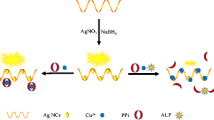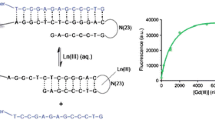Abstract
The authors describe a molecular beacon-based fluorescent probe for the determination of the cancer drug bleomycin (BLM). The probe was tagged with DNA-templated silver nanoclusters (DNA-AgNCs) and guanine-rich sequences (GRSs) at two terminals serving as signal reporter with a loop. In the absence of the BLM-iron(II) complex [BLM-Fe(II)], the probe has a hairpin shape and displays strong fluorescence because the AgNCs are close to the GRSs. In the presence of the BLM-Fe(II) complex, it will selectively cleave the probe at the 5’-GC-3′ scission site of the loop. This displaces the AgNCs away from the GRSs and causes a decrease in fluorescence, best measured at excitation/emission wavelengths of 565/623 nm. This effect enables BLM to be detected with a detection limit as low as 33 pM, which was 1–3 orders of magnitude more sensitive than most of the previous reports. The probe was applied for the determination of BLM in spiked human serum samples, and excellent performance was achieved. In our perception, the method described here represents a promising tool for highly sensitive and specific analysis of BLM during cancer treatment.

Schematic of a highly sensitive fluorometric assay forbleomycin. It is based on molecular beacon-templated silver nanoclusters and DNA scission.





Similar content being viewed by others
References
Sleijfer S (2001) Bleomycin-induced pneumonitis. Chest 120:617–624
Kievit FM, Zhang M (2011) Cancer nanotheranostics: improving imaging and therapy by targeted delivery across biological barriers. Adv Mater 23:217–247
Sleijfer S, Vujaskovic Z, Limburg PC, Koops HS, Mulder NH (1998) Induction of tumor necrosis factor-α as a cause of bleomycin-related toxicity. Cancer 82:970–974
Choi YS, Kim HB, Kim SH, Choi J, Park JK (2009) Microdevice for analyzing the effect of electrochemotherapy on cancer cells. Anal Chem 81:3517–3522
Peng RQ, Sridhar S, Tyagi G, Phillips JE, Garrido R, Harris P, Burns L, Renteria L, Woods J, Chen L, Allard J, Ravindran P, Bitter H, Liang Z, Hogaboam CM, Kitson C, Budd DC, Fine JS, Bauer CMT, Stevenson CS (2013) Bleomycin induces molecular changes directly relevant to idiopathic pulmonary fibrosis: a model for “active” disease. PLoS One 8:e59348
Kosjek T, Krajnc A, Gornik T, Zigon D, Groselj A, Sersa G, Cemazar M (2016) Identification and quantification of bleomycin in serum and tumor tissue by liquid chromatography coupled to high resolution mass spectrometry. Talanta 160:164–171
Galba J, Veizerova L, Piestansky J, Mego M, Novotny L, Dokupilova S, Marakova K, Havranek E, Mikus P (2015) HPLC-QTOF-MS method for identification and determination of bleomycin A2 and B2 fractions. J Liq Chromatrogr R T 38:294–302
D’Hondt M, Gevaert B, Wynendaele E, Spiegeleer BD (2016) Implementation of a single quad MS detector in routine QC analysis of peptide drugs. J. Pharmaceut Biomed 6:24–31
Sohda M, Fujiwara K, Saikusa H, Kitagawa T, Nakamura N, Hara K, Tone H (1985) Sensitive enzyme immunoassay for the quantification of aclacinomycin a using beta-D-galactosidase as a label. Cancer Chemoth Pharm 14:53–58
Teale JD, Clough JM, Marks V (1977) Radioimmunoassay of bleomycin in plasma and urine. Brit J Cancer 35:822–827
Li F, Feng Y, Zhao C, Tang B (2011) Simple colorimetric sensing of trace bleomycin using unmodified gold nanoparticles. Biosens Bioelectron 26:4628–4631
Yin XB, Xin YY, Zhao Y (2009) Label-free electrochemiluminescent aptasensor with attmolar mass detection limits based on a Ru(phen)3 2+-double-strand DNA composite film electrode. Anal Chem 81:9299–9305
Pei H, Zheng Y, Kong R, Xia L, Qu F (2016) Niche nanoparticle-based FRET assay for bleomycin detection via DNA scission. Biosens Bioelectron 85:76–82
Yan XL, Zhao XE, Sun J, Zhu SY, Lei CH, Li R, Gong PW, Ling BP, Wang RJ, Wang H (2018) Probing glutathione reductase activity with graphene quantum dots and gold nanoparticles. Sensor Actuat B 263:27–35
Zhao XE, Lei CH, Gao Y, Gao H, Zhu SY, Yang X, You JM, Wang H (2017) A ratiometric fluorescent nanosensor for the detection of silver ions using graphene quantum dots. Sensor Actuat B 253:239–246
Zhu SY, He L, Zhang F, Li MY, Jiao SL, Li Y, Chen MY, Zhao XE, Wang H (2016) Fluorimetric evaluation of glutathione reductase activity and its inhibitors using carbon quantum dots. Talanta 161:769–774
Giroux RA, Hecht SM (2010) Characterization of bleomycin cleavage sites in strongly bound hairpin DNAs. J Am Chem Soc 132:16987–16996
Li F, Feng Y, Zhao C, Li P, Tang B (2012) A sensitive graphene oxide-DNA based sensing platform for fluorescence “turn on” detection of bleomycin. Chem Commun 48:127–129
Gao FL, Lei JP, Ju HX (2013) Ultrasensitive fluorescence detection of bleomycin via exonuclease III-aided DNA recycling amplification. Chem Commun 49:7561–7563
Qin YF, Ma YF, Jin X, Zhang LL, Ye GJ, Zhao SL (2015) A sensitive fluorescence turn-on assay of bleomycin and nuclease using WS2 nanosheet as an effective sensing platform. Anal Chim Acta 866:84–89
Kong RM, Sun NN, Qu FL, Wu HY, Wang H, You JM (2015) Sensitive fluorescence “turn on” detection of bleomycin based on a superquenched perlene-DNA complex. RSC Adv 5:86849–86854
Zhu SY, Zhao XE, Zhang W, Liu ZY, Qi WJ, Anjum S, Xu GB (2013) Fluorescence detection of glutathione reductase activity based on deoxyribonucleic acid-templated silver nanoclusters. Anal Chim Acta 786:111–115
Borghei YS, Hosseini M, Ganjali MR (2017) Fluorometric determination of microRNA via FRET between silver nanoclusters and CdTe quantum dots. Microchim Acta 184:4713–4721
Yeh HC, Sharma J, Han JJ, Martinez JS, Werner JH (2010) A DNA-silver nanocluster probe that fluoresces upon hybridization. Nano Lett 10:3106–3110
Cao Q, Teng Y, Yang X, Wang J, Wang EK (2015) A label-free fluorescent molecular beacon based on DNA-ag nanoclusters for the construction of versatile biosensors. Biosens Bioelectron 74:318–321
Li J, Zhong X, Zhang H, Le XC, Zhu JJ (2012) Binding-induced fluorescence turn-on assay using aptamer-functionalized silver nanocluster DNA probes. Anal Chem 84:5170–5174
Li J, Jia X, Li D, Ren J, Han Y, Xia Y, Wang E (2013) Stem-directed growth of highly fluorescent silver nanoclusters for versatile logic devices. Nanoscale 5:6131–6138
Wang HB, Li Y, Bai HY, Liu YM (2018) DNA-templated au nanoclusters and MnO2 sheets: a label-free and universal fluorescence biosensing platform. Sensor Actuat B 259:204–210
Li JY, Fu WX, Bao JC, Wang ZY, Dai ZH (2018) Fluorescence regulation of copper nanoclusters via DNA template manipulation toward design of a high signal-to-noise ratio biosensor. ACS Appl Mater Interfaces 10:6965–6971
Su YT, Lan GY, Chen WY, Chang HT (2010) Detection of copper ions through recovery of the fluorescence of DNA-templated copper/silver nanoclusters in the presence of mercaptopropionic acid. Anal Chem 82:8566–8572
Mohanty J, Barooah N, Dhamodharan V, Harikrishna S, Pradeepkummar PI, Bhasikuttan AC (2013) Thioflavin T as an efficient inducer and selective fluorescent sensor for the human telomeric G-quadruplex DNA. J Am Chem Soc 135:367–376
Wang HJ, Jiang W, Li W, Wang L (2017) A bicyclo-hairpin probe mediated strand displacement amplification strategy for label-free and sensitive detection of bleomycin. Sensor Actuat B 238:318–324
Li HY, Wang CF, Gai PP, Hou T, Ge L, Li F (2016) Unique quenching of fluorescent copper nanoclusters based on target-induced oxidation effect: a simple, label-free, highly sensitive and specific bleomycin assay. RSC Adv 6:76679–76683
Chang Y, Zhang P, Yu Y, Du YQ, Wang W, Huang CZ (2013) DNA-templated silver nanoclusters as label-free fluorescent probes for detection of bleomycin. Anal Methods 5:6200–6204
Acknowledgements
This work is kindly supported by the National Natural Science Foundation of China (Nos. 21405094, 21775088, and 81403051), the Natural Science Foundation of Shandong Province (Nos. ZR2017MC037, ZR2017QB008), the Natural Science Foundation of Qinghai Province of China (2016-ZJ-955), and the Development Project of Qinghai Key Laboratory (No. 2017-ZJ-Y10), and the Open Funds of Shandong Key Laboratory of TCM Quality Control Technology of Shandong Academy of Sciences. We also thank Xiaoqing Qu for her good advice in the design of DNA.
Author information
Authors and Affiliations
Corresponding author
Ethics declarations
The authors declare that they have no competing interest.
Electronic supplementary material
ESM 1
(DOC 230 kb)
Rights and permissions
About this article
Cite this article
Yan, X., Sun, J., Zhao, XE. et al. Molecular beacon-templated silver nanoclusters as a fluorescent probe for determination of bleomycin via DNA scission. Microchim Acta 185, 403 (2018). https://doi.org/10.1007/s00604-018-2939-7
Received:
Accepted:
Published:
DOI: https://doi.org/10.1007/s00604-018-2939-7




